Contents
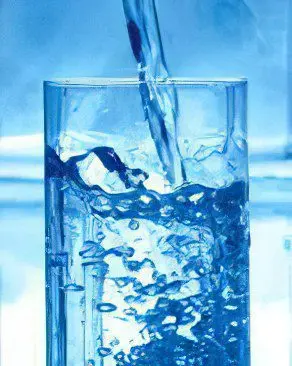
Shank prakshalana – This method is very simple to perform, while effective. This is a yoga salt water bowel cleansing method. Shank prakshalana cleanses the entire colon and removes food debris from the digestive tract, from the stomach to the anus.
When you drink salt water, it enters the stomach and then, with the help of simple exercises, the water is sent further, through the entire intestine to the very exit from it. The procedure is repeated until the water comes out as clean as it enters. This procedure is absolutely safe, anyone can perform it, but subject to the exact implementation of all techniques.
In 2010, there was even a pilot study published in the Journal of Alternative and Complementary Medicine. It showed that alternating between drinking warm salt water and doing certain yoga poses effectively cleansed the colon in preparation for a colonoscopy.
Preparing for a colon cleanse with salt water
For one liter of heated water, dissolve one tablespoon of sea salt (or unrefined table salt), the concentration is higher than in saline. Salt water should be so that it is not absorbed by osmosis through the mucous membrane and is not removed from the body naturally (in the form of urine). If the water seems too salty to you, you can reduce the salt concentration to a more acceptable taste.
It should be borne in mind that drinking salt water is difficult and many immediately begin to feel sick. To reduce nausea, you can add some lemon juice to your water.
Favorable moment of bowel cleansing
The best time for this procedure is in the morning, before eating.
Keep in mind that for a beginner, this procedure takes more than an hour, so it’s best to do it on a day off. On this day, avoid performing asanas, or sharp exercises, and the next day too.
1. Fill the glass with warm (about 40 °C) salty water (the temperature of the water should be the same as the temperature of the soup that you eat with pleasure).
2. Immediately do special exercises.
3. Drink another glass of salted water, and do the exercises again.
4. Alternate the drunk glass with special exercises until 6 glasses of salt water are drunk and, accordingly, six series of exercises are done.
5. After you have done all this, you need to go to the toilet.
As a rule, the first evacuation occurs almost immediately. Normal solid stools are followed by softer stools, and then completely liquid ones (most likely yellowish in color).
If this does not happen immediately or within 5 minutes, then repeat the set of exercises and go to the toilet.
If there is no result again, which is unlikely, but it happens, then call for an evacuation using an enema from non-salt water (after making a small enema, lie down and relax for a few minutes). After the evacuation mechanism works, the rest will be called automatically.
One very useful tip: do not use toilet paper after a bowel movement, but it is best to wash yourself with water, then carefully wipe the anus and lubricate it with vegetable oil (olive, castor, etc.): this will help to avoid various irritations caused by salt.
After the first bowel movement, you should:
Drink a glass of salted water again;
Do a course of exercises;
Go to the toilet to empty your bowels.
Continue doing this (drink salt water – exercise – bowel movements) until the water at the exit is as pure as it enters the body. It all depends on how polluted the intestines are, usually 10-14 glasses of salt water are enough (usually no more is needed).
When you are satisfied with the results of the procedure (the outgoing water becomes clear), you can stop the procedure. At the end of the procedure, you may still feel the desire to go to the toilet for the next hour, this is perhaps the only inconvenience.
Another recommendation: it is advisable to drink three glasses of salt water after the procedure (if there is a suspicion of hyperacidity, then do it without salt, with a pinch of baking soda) and do vamana dhauti (induce vomiting), with three fingers of your right hand, tickle the back surface of the upper palate and tongue . This will completely empty the stomach and turn off the evacuation mechanism.
In case of failure
If suddenly, after drinking four glasses of salt water, you feel that the liquid in the stomach does not pass normally into the intestines, while you feel stomach fullness and nausea, this indicates that the first sphincter did not open properly. We’ll fix it all. To do this, do not drink more fluids, but do two or three sets of exercises. As soon as the feeling of nausea passes, this will indicate that the passage to the stomach has opened. After the evacuation mechanism is launched, there will be no more difficulties, you can safely continue the procedure.
Sometimes it happens that a gas plug has formed in the intestines, which prevents the evacuation mechanism from being put into operation. To fix this, you just need to press on your stomach with your hands or do a sarvangasana or “plow” (stand on the shoulder blades, it is also possible to do a “plow” in a simplified version, not straightening up much and not touching the floor with your feet for one minute), as well as the rest four exercises.
In the worst case, when the liquid does not come out no matter what you do, you just have to decide and make vamana dhauti (induce vomiting), to do this, tickle the base of the tongue with three fingers of your right hand, you can do nothing, then the water will come out naturally like urine.
After the procedure, rest and avoid feeling hungry.
It is important to consider!
There are 2 conditions, without which you may not succeed:
The water should be warm, around 40°C. If it is slightly warm or generally cold, there will be problems!
The water must be very salty! Be sure to be saltier than blood, otherwise it will not go through the intestines, but will be excreted by the kidneys – and this is a strong blow to the kidneys!
First meal
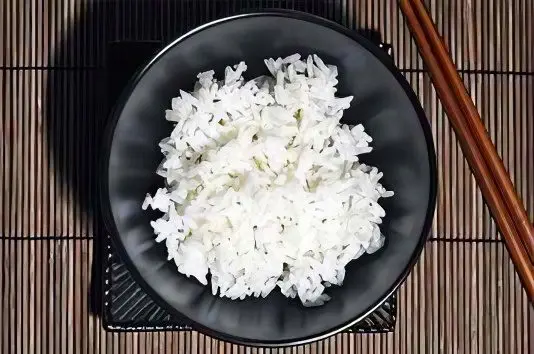
After shank prakshalana, some recommendations must be followed. There is no earlier than half an hour and no later than an hour after the procedure. It is forbidden to leave the digestive tract hungry for more than an hour!
What should be the first meal? Cleaned rice boiled in water, but not very boiled (the grains should melt in your mouth). You can add a little salted tomato juice to rice, you can not use pepper and various spicy seasonings. You can add well-cooked lentils or carrots to rice. Together with rice, you need to eat 40 grams of butter. Butter can be melted in rice, but it is better to do it separately, in a water bath, or eat from a spoon without melting. Instead of rice, you can use boiled wheat, oats or flour products (pasta, noodles, spaghetti, etc.) seasoned with grated cheese.
Attention! Rice is not allowed to boil in milk. Also, over the next day, you can not drink milk or kefir, and acidic food and drink, fruits and raw vegetables are also contraindicated. Bread can be eaten during the second meal. Any hard and semi-hard cheeses are not prohibited. Not recommended, there are white and fermented cheese (brie, camembert).
At the end of the day, you can switch to your usual diet, limiting only the consumption of meat.
Drink
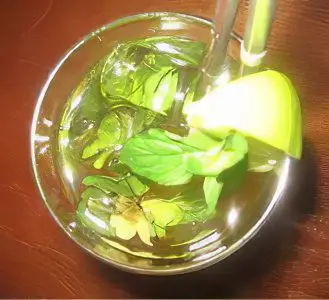
Salt water will direct some of your body fluid to the digestive tract. This will be the main part of the cleansing. After the procedure, you will feel thirsty. But you should not drink any liquid, even clean water, before the first meal, as you will support the evacuation mechanism and continue to go to the toilet.
After the first meal, you can drink water and weak infusions: linden-mint infusion, mineral water (slightly carbonated or still). Alcohol consumption during the day is strictly prohibited!
The first bowel movements will appear 24 or 36 hours after the procedure, don’t let that worry you. They will be golden yellow in color and will not smell like a baby. It is good to carry out such a procedure at least twice a year. The average frequency of its holding is four times a year (depending on the change of season). People who are serious about cleansing can do this procedure every month. Dhirendra Brahmachari recommends doing shank prakshalana once every 15 days.
In general, this procedure cannot be called pleasant, of course, there are more pleasant activities. The most unpleasant thing in this procedure is drinking warm salty water, the rest does not matter. People with a delicate taste can be offered to drink from a weak decoction of onions – leeks or other vegetables.
People who suffer from constipation can do shank prakshalana every week, but should limit themselves to six glasses of water. In this case, the entire procedure will take approximately 30 minutes. This is a very good “exercise” for the intestines, and the walls of the colon do not stretch.
Benefits of colon cleansing
The first result of cleansing the intestines with salt water is getting rid of impurities, deposits that have been absorbed into the mucous membrane of the colon. You can be horrified by what the intestines can absorb into themselves. Many people who do not suffer from constipation, systematically empty their intestines, mistakenly assume that they cannot have anything in their intestines. But what will be their surprise when they find a cherry pit swallowed several months ago among the removed “waste”. It is often surprising in a yoga hospital how many different wastes can remain in the intestines, accumulate there for months and even years. It is amazing that there can be so many impurities in a person, is it worth wondering after that where various diseases come from, when the whole body is literally poisoned by the toxins accumulated in it.
In any case, it is unreasonable to put up with it. Therefore, it is worth performing shank prakshalana and getting rid of those deposits that have accumulated in your digestive tract. The positive effect of this procedure will not affect the next day and will not be evident to everyone, but it will definitely manifest itself in the form of fresh breath, the skin on the face and body will be cleansed. Of course, if you follow a low-toxic diet (without excess meat), bodily odors, which are very strong, will disappear, and the complexion will improve. Among other things, this procedure has a tonic and stimulating effect on the liver (this will be noticeable by the color of the excrement).
Doctors Lonovaly successfully healed diabetic patients in the initial stage by performing shank prakshalana once every two days for two months (the diet, pranayama and other yogic procedures were also observed).
It is likely that the pancreas, under the influence of general stimulation, produces more insulin.
Also, colds and other diseases associated with metabolism, and seemingly having nothing to do, are also quite easily and quickly cured.
One of the most important results of doing shank prakshalana is getting rid of allergic diseases.
The result of cleansing the digestive tract is good digestion of food, which leads to the fact that the thin get better, and those who need to lose weight lose weight.
Contraindications for colon cleansing with salt water
There are few contraindications. These are people with stomach ulcers, first they must heal the ulcer, and then they can be treated for peptic ulcer by performing shank prakshalana. The same recommendation for those who have diseases of the digestive tract during an exacerbation is dysentery, diarrhea, acute colitis (chronic colitis after performing this procedure can be significantly alleviated, again, you should not perform it during an exacerbation), acute appendicitis and, moreover crayfish.
Apparently, these contraindications are not final. In practice, there is a unique case of curing dysentery with shank prakshalana, despite the fact that before that the patient had previously undergone a standard course of treatment, and he did not bring him relief.
This procedure is very effective at the final stage of the course of treatment for oxyurosis.
In fact, when all the contents of the intestine are evacuated, the worms with their eggs also come out. But still, there are so many of them that some of the eggs may remain.
In order for water to pass through the entire digestive tract, it is enough to perform the exercises below. Each movement must be performed four times in each direction in turn at a fast pace: the entire series of these exercises takes about one minute (or faster).
Exercises
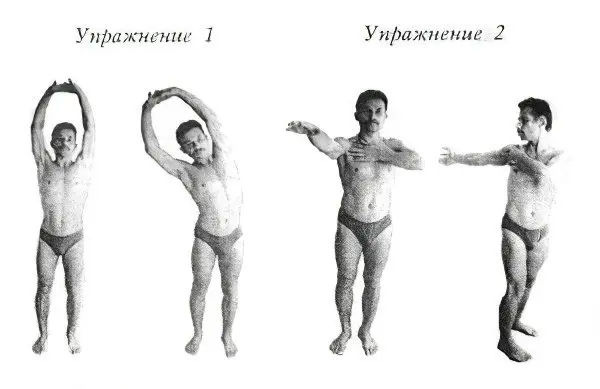
First exercise. Starting position: standing, the distance between the feet is approximately 30 cm, the fingers are interlaced, palms up. The back is straight, breathing is even and free. Standing straight, tilt first to the left, smoothly without stopping, lean to the right. Do such tilts in both directions four times, in other words, do alternately 8 tilts to the left and right. In general, this should take approximately 10 seconds.
This exercise opens the pylorus. With each tilt, part of the water leaves it, passing into the duodenum and small intestine.
Second exercise. This exercise forces water to flow through the small intestine. Starting position: standing, legs apart, stretch the right hand forward horizontally, and bend the left so that the index and thumb touch the right collarbone. Make turns of the torso, moving the outstretched arm as far back as possible (while looking at the fingertips). Not forgetting at the same time that the lower part of the body must remain motionless, that is, turns are made not with the whole body, but around the waist. At the end of the turn, without stopping, return to the starting position and immediately turn to the other side. This double exercise should also be repeated four times. The duration of this series of exercises is approximately 10 seconds.
Third exercise. In order for the water to continue to move through the small intestine, it is necessary to perform a cobra variation, but at the same time the big toes should touch the floor, and the hips, therefore, should be raised off the floor. The feet are 30 cm apart, which is very important. Having taken this position, turn your head, shoulders and torso until you see the opposite heel (if you turn to the right, then you need to see the left heel). Again, without stopping, return to the starting position and turn in the other direction. Turns are made only by the upper body, the lower part remains motionless and parallel to the floor. Only downward bends are allowed. Double exercise is repeated 4 times. Duration 10 – 15 seconds.
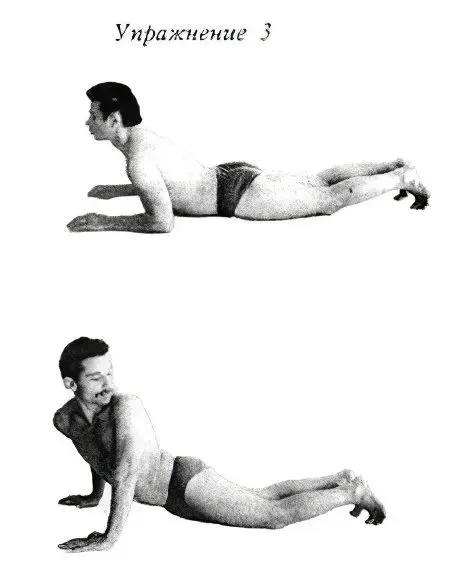
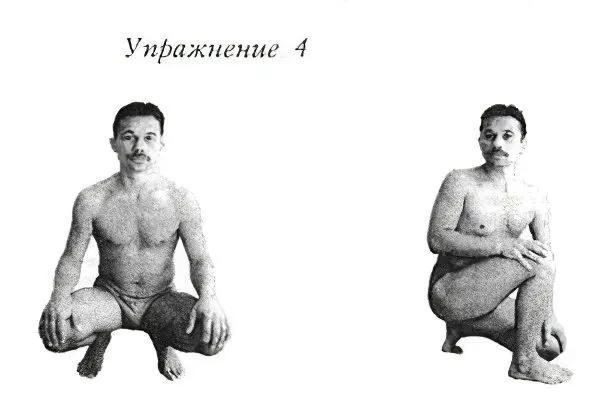
Fourth exercise. This exercise is aimed at ensuring that the water that has already reached the end of the small intestines is passed through the large intestine. Of all the exercises, this is perhaps the most difficult, but accessible to everyone, with the exception of people with diseases of the lower leg and meniscus.
Starting position: squat down, feet apart about 30 cm apart, while the heels are located at the outer part of the hips, and not under the buttocks, the hands are on the knees, the knees are also separated by about 30 cm. Then turn the torso and lower the knee on the floor in front of the opposite foot. The palms alternately direct the right thigh to the left side and the left thigh to the right side so as to press on one side of the abdomen and press on the large intestines. Turn your head back in order to increase the twisting of the torso and put more pressure on the stomach.
First you need to apply pressure on the right side of the abdomen in order to put pressure on the ascending colon. Unlike previous exercises, in which it was not important which way to start doing (right or left).
Like other exercises, this should also be done 4 times. Duration 15 sec.
If suddenly this exercise, for some reason, is difficult to perform, it can be replaced with the “lazy” plow exercise for one minute, then lie down and relax for one minute.









